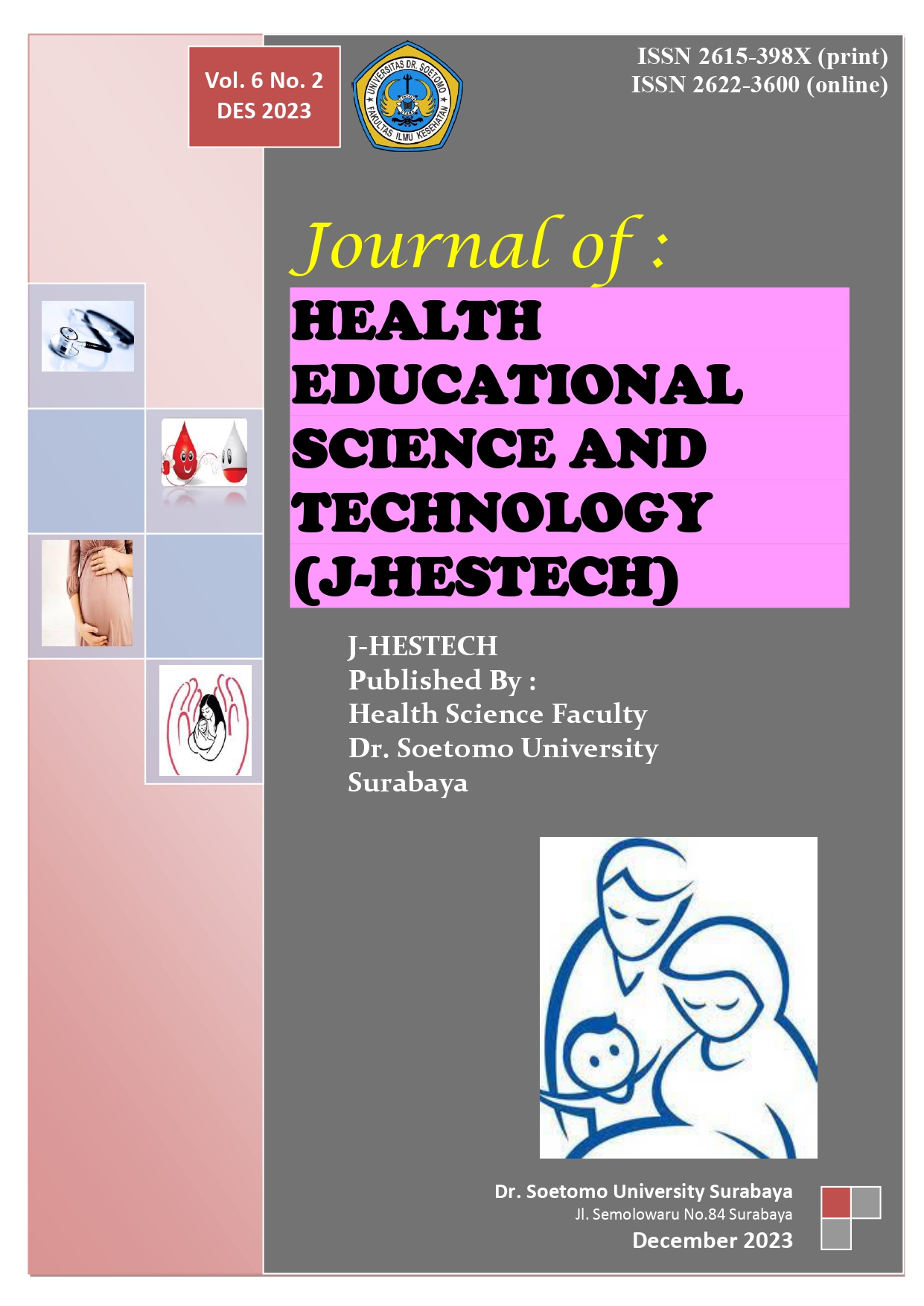Deteksi Genetik Sars-Cov-2 di Swab Lingkungan Asrama Mahasiswa Fakultas Keperawatan
 Abstract views: 155
,
Abstract views: 155
,
 PDF downloads: 169
PDF downloads: 169
Abstract
Pemerintah telah menerapkan serangkaian langkah khusus untuk mengendalikan penyebaran virus SARS-CoV-2 di tempat kerja dan lingkungan sosial. Proses pengendalian ini sangat penting, karena ketidakmampuan untuk menemukan carriers/ pembawa sebelum menunjukkan dan tanpa gejala, dapat mengganggu efektivitas proses pengendalian. Penularan SARS-CoV-2 dari pasien bergejala dan tanpa gejala terjadi melalui droplet yang dikeluarkan saat batuk atau bersin tanpa menutup mulut atau hidung. Namun, hal ini tentu tidak menutup kemungkinan terjadinya infeksi melalui kontak sentuhan pada permukaan benda dan lingkungan. Hipotesis fomite ini dianalisis dengan menguji sampel swab lingkungan menggunakan metode PCR kuantitatif Reverse Transcription (RT-qPCR). Dalam penelitian ini, deteksi genetik yang dilakukan di 13 titik di asrama mahasiswa Universitas Pelita Harapan selama bulan November 2021, enam sampel dinyatakan positif, ditunjukkan dengan Cycle threshold (Ct) RT-qPCR yaitu di lantai 15: lift luar kancing (Ct= 36,69), kancing mesin cuci (Ct=37,24), gagang pintu kamar (Ct=36,79), gagang lemari es (Ct=36,6); di lantai 16: tombol lift luar (Ct=37,47) dan pegangan kursi tunggu lift (Ct=37,84).
References
CDC and ICAN. 2019. Best Practices for Environmental Cleaning in Healthcare Facilities in Resource-Limited Settings. Atlanta, GA: US Department of Health and Human Services, CDC; Cape Town, South Africa: Infection Control Africa Network; (https://www.cdc.gov/hai/pdfs/resource-limited/environmental-cleaning-RLS-H.pdf).
Centers for Disease Control and Prevention. CDC 2019-novel coronavirus (2019-nCoV) real-time RT-PCR diagnostic panel [cited 2020 Mar 1]. https://www.fda.gov/media/134922/download.
Centers for Disease Control and Prevention, 2020. Chemical Disinfectants Guideline for Disinfection and Sterilization in Healthcare Facilities. Phenolics. Available to: http://www.cdc.gov/infectioncontrol/guidelines/disinfection/disinfection-methods/chemical.html.
Chin, A.W.H., Chu, J.T.S., Perera, M.R.A., Hui, K.P.Y., Yen, H.-L., Chan, M.C.W., et al. 2020. Stability of SARS-CoV-2 in different environmental conditions. The Lancet Microbe S2666524720300033. (https://doi.org/10.1016/S2666- 5247(20)30003-3).
Gon, G., Dancer, S., Dreibelbis, R., Graham, W.J., Kilpatrick, C., 2020. Reducing hand recontamination of healthcare workers during COVID-19. Infect. Control Hosp. Epidemiol. 1–2. (https://doi.org/10.1017/ice.2020.111).
Guo ZD, Wang ZY, Zang SF, Li X, Li L, Li C et al. 2020. Aerosol and Surface Distribution of severe acute respiratory syndrome coronavirus 2 in hospital wards, Wuhan, China, 2020. Emerg Infect Dis 2:1586–1591.
Han Y, Yang H. The transmission and diagnosis of 2019 novel coronavirus infection disease (COVID-19): A Chinese perspective. J Med Virol. 2020; published online March 6. DOI: 10.1002/jmv.25749.
Jansson, Linda & Akel, Yasmine & Eriksson, Ronnie & Lavander, Moa & Hedman, Johannes. 2020. Impact of swab material on microbial surface sampling. Journal of Microbiological Methods. 176. 106006. 10.1016/j.mimet.2020.106006.
Kampf, G., Todt, D., Pfaender, S., Steinmann, E. 2020. Persistence of coronaviruses on inanimate surface and their inactivation with biocidal agents. J. Hosp. Infect. 104, 246-251.
Kit insert VIRSeek SARS-CoV-2 Mplex, Version 1.
Kohler, A.T., Rodloff, A.C., Labahn, M., Reinhardt, M., Truyen, U., Speck, S., 2018. Efficacy of sodium hypochlorite against multidrug-resistant Gram-negative bacteria. J Hosp Infect 100, e40–e46. (https://doi.org/10.1016/j.jhin.2018.07.017).
Pereira, S.S.P., Oliveira, H.M. de, Turrini, R.N.T., Lacerda, R.A., 2015. Disinfection with sodium hypochlorite in hospital environmental surfaces in the reduction of contamination and infection prevention: a systematic review. Rev. esc. enferm. USP 49, 0681–0688. (https://doi.org/10.1590/S0080-623420150000400020).
Riedel S, Morse S, Mietzner T, Miller S. Jawetz, Melnick, Adelberg. 2019. Medical Microbiology. 28th ed. New York: McGrawHill Education/ Medical. p.617-22.
Rothan HA, Byrareddy SN. 2020. The epidemiology and pathogenesis of coronavirus disease (COVID-19) outbreak. J.Autoimmun. Published online March 3. DOI: 10.1016/j.jaut.2020.102433.
Van Doremalen N, Bushmaker T, Morris DH, et al. 2020. Aerosol and Surface Stability of SARS-CoV-2 as Compared with SARS-CoV-1. New England Journal of Medicine.
World Health Organization (WHO)a. 2020. Cleaning and disinfection of Enviromental Survace in the context of Covid-19, Interim Guidance (15 May 2020).
World Health Organization (WHO)b. 2020. Essential environmental health standards in health care. Geneva: (https://www.who.int/water_sanitation_health/publications/ehs_hc/en/).
World Health Organization (WHO)c. 2020. Laboratory biosafety guidance related to the novel Coronavirus (2019-nCoV). Appropriate disinfectants. Available to: https://www.who.int/docs/defaultsource/coronaviruse/laboratory-biosafety-novel-coronavirus-version-1-1.pdf.
Ye, G., H. Lin, S, Chen, S, Wang, Z. Zeng, W. Wang, S. Zhang, T. Rebmann, Y. Li, Z. Pan, Z. Yang, Y. Wang, F. Wang, Z. Qian, and X. Wang. 2020. Environmental Contamination of SARS-CoV-2 in Healthcare Premises. Journal of Infection. 81. e1-e5. Elsevier.
Yuwono, Tribuwono. 2006. Teori dan Aplikasi Polymerase Chain Reaction. Penerbit Andi. Yogyakarta.
Zhu N, Zhang D, Wang W, Li X, Yang B, Song J et al. 2020. A novel coronavirus from patients with pneumonia in China. N Engl. J Med 382:727–733.














